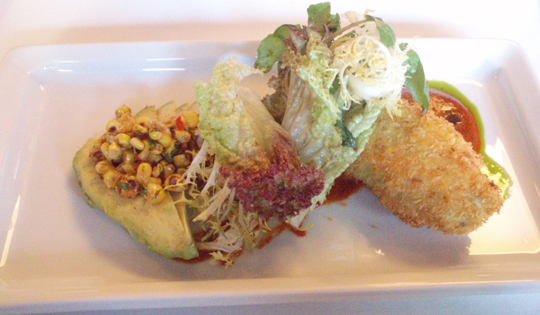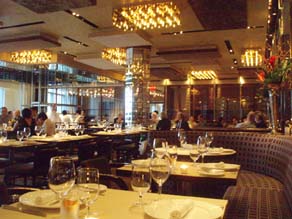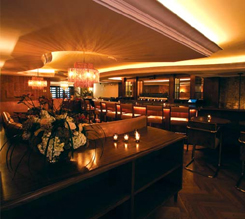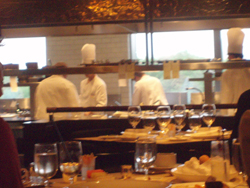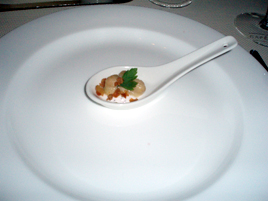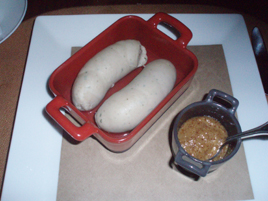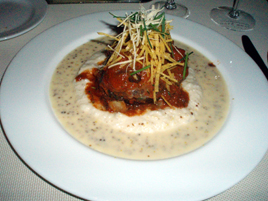Elizabeth
 Saturday, May 31, 2008 at 04:38PM
Saturday, May 31, 2008 at 04:38PM 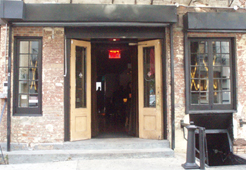
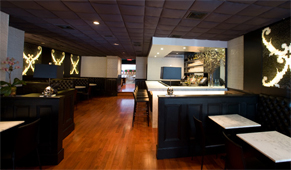
Note: There was a series of chef chuffles after this review was written. Elizabeth finally closed in early 2011.
*
The new restaurant Elizabeth showcases several recent trends.
 In the first place, we have a former three-star chef working in much humbler surroundings—trying to “make it small” after he’d already made it big. That chef is Doug Psaltis, who worked at both The French Laundry and Country. In the second place, Psaltis is merely consulting, with another former colleague from Country, John Iconomou, in the kitchen day-to-day.
In the first place, we have a former three-star chef working in much humbler surroundings—trying to “make it small” after he’d already made it big. That chef is Doug Psaltis, who worked at both The French Laundry and Country. In the second place, Psaltis is merely consulting, with another former colleague from Country, John Iconomou, in the kitchen day-to-day.
Lastly, there’s a “small plates” format, which at its best encourages grazing and sharing, but at its worst encourages over-ordering or leaves the customer confused about how much to order.
 In part, these trends reflect the preferences of some younger diners, who want to enjoy haute cuisine without putting on a coat and tie, who don’t want to be locked into the standard three-course meal, and who don’t want to pay the higher prices that fancier restaurants need to charge to recover their overheads. These trends also reflect tough economic times: the risks and the capital required to open a multi-starred restaurant.
In part, these trends reflect the preferences of some younger diners, who want to enjoy haute cuisine without putting on a coat and tie, who don’t want to be locked into the standard three-course meal, and who don’t want to pay the higher prices that fancier restaurants need to charge to recover their overheads. These trends also reflect tough economic times: the risks and the capital required to open a multi-starred restaurant.
Some of the post-modern, deconstructed restaurants are terrific. Others are derivative—pedestrian—ordinary. Elizabeth is in the latter camp.
The space is configured somewhat like a railroad apartment, with several dark rooms in sequence, leading to a bright, cheery garden space with a large skylight. The garden looks like it dropped in from another restaurant; it looks like nothing like the indoor space. Most patrons seem to prefer the garden. It was full at 6:30 p.m. on a Friday night, but the dark indoor rooms, where we were seated, were empty. They started to fill up a bit later on.
The menu is divided into three categories with five dishes apiece: First ($8–14), Second ($11–13) and Third ($14–19). Naturally, the idea is to encourage you to order one from each category, though we ignored that advice. If our experience is any guide, one appetizer and one entrée (selected from the third category) is sufficient unless you’re unusually hungry.
For the record, desserts are $7–9, a cheese plate $13. House cocktails, at $12–14, are a bit over-priced in relation to the rest of the menu. The wine list is more reasonable, though it is less than half a page, with about 10 choices by the glass and another 10 by the bottle. We had a respectable Shiraz for $45.
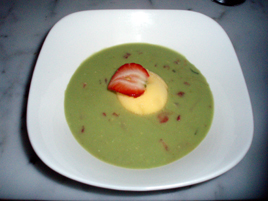
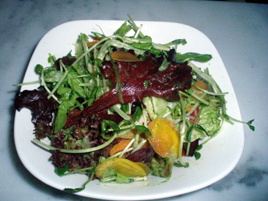
A Green Gazpacho ($9) with cucumber and passion fruit was probably the best thing we tasted, cool and summery. In the middle of the bowl was a scoop of mango sorbet; the soup was poured over it at tableside.
A lettuce salad ($8) was competently done.
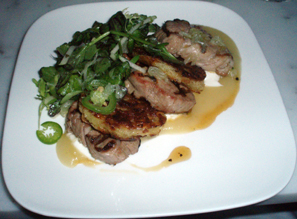

Pork Tenderloin ($14) was prepared in the traditional manner, with applesauce, sour cream, and potato latkes. A Crispy Cheese Burger ($14) wasn’t tender enough. It was served with a bizarre frisbee of burnt cheese that was twice the diameter of the bun. Fries ($5) were huge and far too mushy on the inside. I called them “horse fries,” meaning that only a horse could love them.
The restaurant has been open for about six weeks. Some early reports complained about service, but we found it mostly under control. We found nothing at Elizabeth that was worthy of the former chef de cuisine at the French Laundry. The kitchen serves decent comfort food.
Elizabeth (265 Elizabeth Street between Houston & Prince Streets, NoLIta)
Food: *
Service: *
Ambiance: *
Overall: *



